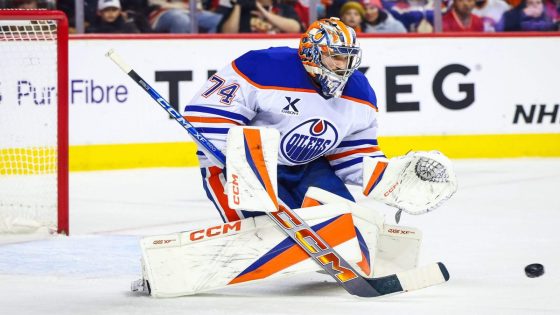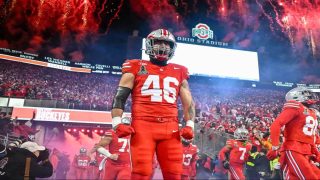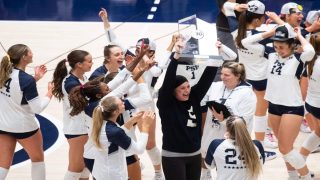At the very beginning of the Edmonton Oilers’ NHL existence, the team took two brilliant young goaltenders in successive drafts.
Andy Moog (seventh round, 1980) and Grant Fuhr (first round, 1981) gifted the fledgling NHL newcomer with two elite-quality keepers. Fuhr would eventually emerge as a Hall of Fame goalie for Edmonton, and Moog would deliver an impressive career across almost two decades.
As is the case for many things in Oilers history, the first chapters of amateur goaltending procurement shone brightly, but the results since have been disappointing.
What followed Fuhr-Moog was a long period of poor drafting and development. Goaltenders drafted by the Oilers often went unsigned, and if they did manage an entry-level deal, they were destined for Europe or retirement in their early 20s.
In recent years, the club has found some traction and may have a goalie pipeline that will pay more dividends in the years to come.
Stuart Skinner
Edmonton’s current starting goaltender, Stuart Skinner, is a feature player on the team and a possible turning point in the team’s direction at an important position.
He’s an Oilers draft pick who landed the big job. He plays a vital role (starting goalie) on a team contending for the Stanley Cup. He’s being paid ($2.6 million this and next season) far less than the average NHL starting goaltender.
Why?
Skinner was brought along slowly by the organization, and that alone can help suppress salary. Fans have seen it happen previously. Men like Ethan Bear, Ryan McLeod and Evan Bouchard have been slow-played in order to keep the second contract (somewhat) under control.
When the salary pressure reaches a certain level, as happened recently with McLeod, the organization has to make a decision on the player. McLeod was dealt to the Buffalo Sabres for a young player (Matt Savoie) just entering Year 1 of his three-year entry deal. Savoie’s contract is under control.
There are also signs the organization, under former general manager Ken Holland and continuing last summer with Jeff Jackson, is focused on finding enough goaltending to run lean (in terms of cap) through the end of the decade and beyond.
It’s a tough position to fade because it’s so important. How much goaltending talent is in the system and under control (a year or more from open free agency) at this time? Plenty, more than at any time in the cap era.
For many years, the Oilers would trade for the NHL starter, run a fringe player as a backup and hire some AHL veterans to fill in the rest of the pro-level depth chart. In the 1990s, a total of 14 goalies were drafted. Five of those men played 10 or more AHL games in their career, and four played in one or more NHL games.
The Oilers were at best inefficient in this area and at worst indifferent about developing goaltenders drafted by the team. During those years, playing time, even in the AHL, was often reserved for a coveted trade acquisition (Steve Passmore) or a hotshot signing from Europe (Tim Thomas). Even when the team found a player, like Thomas, there was no path for the player to move to the NHL. Thomas would find his NHL home with the Boston Bruins.
Edmonton went on with the game plan: established and proven, leaving development and risky auditions to other teams.
The current situation
| Player | Age-Level | Role |
|---|---|---|
|
Stuart Skinner
|
26-NHL
|
Starter
|
|
Calvin Pickard
|
32-NHL
|
Backup
|
|
Olivier Rodrigue
|
24-AHL
|
Co-starter
|
|
Collin Delia
|
30-AHL
|
Co-starter
|
|
Connor Ungar
|
22-ECHL
|
Backup
|
|
Samuel Jonsson
|
20-Allsvenskan
|
Backup
|
|
Nathan Day
|
19-OHL
|
Starter
|
|
Eemil Vinni
|
18-Finnish U20
|
Backup
|
I don’t recall a time in Oilers NHL history that the club boasted an NHL starter who was drafted and developed by the team, in addition to three legit goalie prospects pushing for future opportunities.
There are bona fide prospects.
Olivier Rodrigue is currently ranked No. 10 in AHL save percentage (.929) and finished in the top 10 in the category in the two previous seasons. He’s close to NHL-ready (if not overcooked) and could be a value contract on the Edmonton roster soon.
Samuel Jonsson is a giant Swedish goalie, playing in the substantial Allsvenskan (Sweden’s second league) this year. He’s playing as a backup, but getting plenty of playing time (eight games) so far this season. His .918 save percentage ranks No. 2 among goaltenders in the league with eight or more games. He’s 6-foot-5 and 200 pounds, a classic modern NHL size. Edmonton may have a real one here.
Eemil Vinni is two years younger than Jonsson but projects to be in the same size range when he’s 20. He’s 6-foot-3 and 187 pounds. He’s an exciting goaltender who plays way out of his net and attacks shooters aggressively. So far in the Finnish junior league this season, his .913 save percentage (in four games) would rank fifth if he had played enough games to qualify.
Three projectable goaltending prospects who are performing well in their respective leagues is unfamiliar territory for the Oilers organization.
Benefits
The major benefit of all this is having options. Three young goalies developing behind Skinner allow all kinds of possibilities.
Skinner’s price point will increase in two seasons if he maintains his current trajectory. If one of the developing goalies pops, it gives management options.
Put another way, one of the pressure points for Ken Holland in the negotiations for the Darnell Nurse contract in 2021 surrounded the career-ending injury to fellow left-handed defenceman Oscar Klefbom.
Edmonton had less room to wheel in negotiations.
If Skinner helps the Oilers to the Stanley Cup while maintaining average or better goalie stats, the next contract is going to increase. Having an internal, inexpensive option may ease the strain of possibly allowing Skinner to walk to free agency in the summer of 2026.
It’s also possible one of Rodrigue, Jonsson or Vinni outplays Skinner upon NHL arrival. That gives management a good problem: Who to trade?
To show how unique the developing situation could be for this organization, here’s an overview of the last 45-plus seasons of goalie procurement via drafting and amateur signings.
The 1980s
The decade was dominated by Fuhr and Moog, so draft picks and amateur signings didn’t get much air at the highest levels of the organization.
Daryl Reaugh (1984 second-round pick) played 27 NHL games, that total would have been higher if the club passed on either of the two big names. Mike Greenlay (a 1986 selection in the ninth round) and Mike Zanier (who signed a pro deal with Edmonton after playing for five WHL teams in junior) got limited playing time during the decade.
The 1990s
Fred Brathwaite is seldom mentioned as an Oilers amateur signing, but he made his NHL debut with Edmonton and would go on (254 NHL games) to a career of note.
The best draft selection in the early part of the decade was Joaquin Gage, who would play 23 games in the NHL after being chosen in the fifth round in 1992. Mike Minard (a 1995 selection) also played one game with the team.
Later in the decade, Mike Morrison (1998, seventh round) was chosen out of U.S. high school. He would have a long development period in college, but did make the NHL in 2005-06 and would play in 29 NHL games.
Adam Hauser, a 1999 third-round pick, would also get into a game (with the Los Angeles Kings) in 2005-06.
The 2000s
| Player | NHL GP | Acquired |
|---|---|---|
|
Devan Dubnyk
|
542
|
2004 first round
|
|
Ty Conklin
|
216
|
Amateur free agent
|
|
Jussi Markkanen
|
128
|
2001 fifth round
|
|
Jeff Deslauriers
|
62
|
2002 second round
|
The Oilers invest some legit draft capital in goaltenders in the 2000s.
The results included a strong No. 1 goaltender (Devan Dubnyk), the best since the Moog-Fuhr drafts of 1980 and 1981. Jeff Deslauriers was also a reasonable bet, but lost a prolonged battle with Dubnyk for the starting role in Edmonton.
Ty Conklin was another significant investment. Several NHL teams were after him, and the Oilers landed the college man.
Finnish goaltender Jussi Markkanen was a veteran when drafted, but (combined with Conklin and Morrison) backstopped the 2005-06 Oilers before and after the trade for veteran goaltender Dwayne Roloson. It was Markkanen who played in Game 7 of the 2006 Stanley Cup Final.
The 2010s
| Player | NHL GP | Acquired |
|---|---|---|
 Stuart Skinner Stuart Skinner |
134
|
2017 third round
|
 Dylan Wells Dylan Wells |
1
|
2016 fifth round
|
 Tyler Bunz Tyler Bunz |
1
|
2010 fifth round
|
Skinner is the big name from this decade. He’s the fourth (Fuhr, Moog and Dubnyk) real success story over 45-plus years of drafting and procurement from other amateur talent pipelines.
The key for management is to develop enough talent for all possible options.
That includes the possibility of Skinner pricing himself out of the cap template created before his arrival. Most of Edmonton’s money is directed at high-end forwards and two or three defencemen. The percentage of cap dollars devoted to goaltending this season (4 percent) won’t have much room to increase with new contracts for Connor McDavid and Evan Bouchard on the way.
The Oilers need value contracts. Among the group that includes Rodrigue, the club may need to develop its next NHL starter.
If Skinner can be signed for a reasonable amount in the summer of 2026 (or sooner), one of those developing prospects could be a valuable trade piece sent away at the deadline.
After ignoring the position for decades, the Oilers appear to be flush in goaltending. It’s a shocking development.
(Photo of Stuart Skinner: Sergei Belski / Imagn Images)





